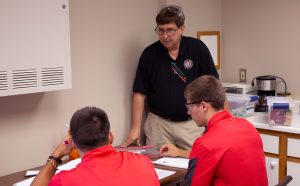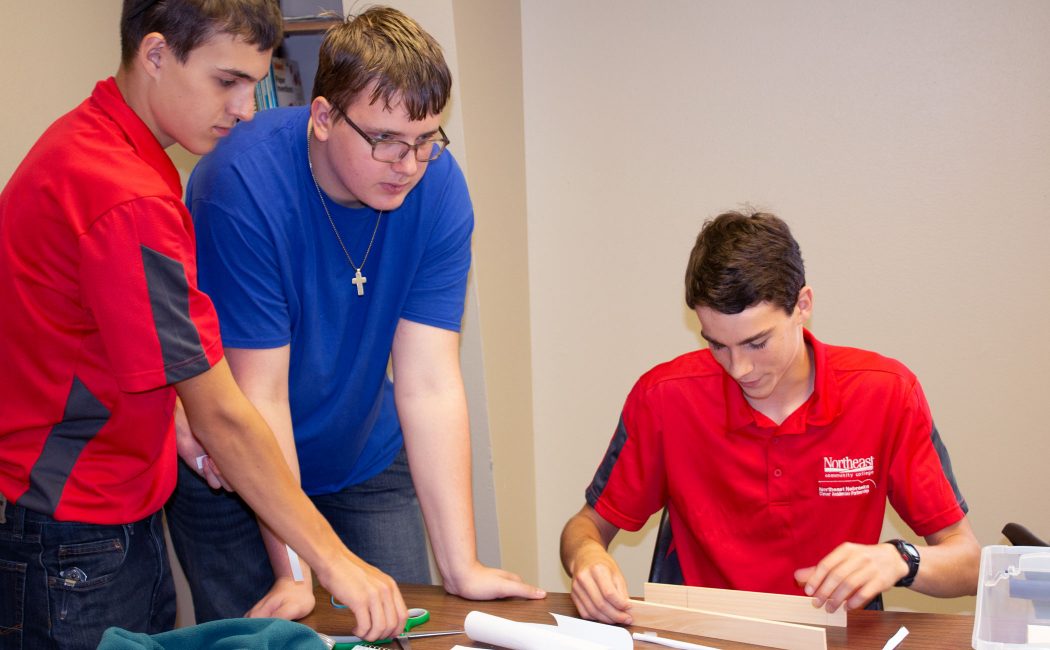
It’s Friday morning in the Maker Space Lab at Northeast Community College in Norfolk, Nebraska, and the room is abuzz — literally and figuratively.
One group of students is hard at work on the 3D printer. Other students collaborate on a computer aided design (CAD) project. Another group concentrates on woodworking with power tools.
It’s just another Friday for Norfolk high school seniors, who are taking advantage of their four-day school week to get ahead on their college credit and post-high school careers through the NCC course known as Introduction to Engineering Design.
As those in the engineering field strive to develop sufficient interest and participation among underrepresented demographic groups, the project aims to build new bridges to narrow those gaps.

At the beginning of the project in fall 2018, Michelle Howell Smith, University of Nebraska Medical Center education researcher and former CYFS research assistant professor, and Kirstie Bash, graduate research assistant, worked with Dave Heidt, NCC chemistry and physics instructor, to determine effective ways to attract and retain rural and underrepresented high school students in engineering fields.
Ray Reichenberg, CYFS research assistant professor, became the project’s principal investigator in 2020.
The pre-engineering course — known as Maker Fridays — was funded by a National Science Foundation grant to NCC, for which Reichenberg, Howell Smith and Bash were subcontractors. The course was one of 18 projects nationwide to receive NSF grant funding designated to advance STEM learning through maker spaces and practice.
The one-semester course was funded for four semesters — one cohort each for fall 2018, and spring and fall 2019, and spring 2020. Classes were taught at NCC’s main Norfolk campus and its South Sioux City extension campus. The two communities were chosen for their populations’ diversity. Because the course was taught at two locations simultaneously, Heidt alternated his teaching location each week while broadcasting live to the other site.
The first group of students enrolled in fall 2018 — eight at the Norfolk campus and four more at South Sioux City’s NCC extension campus.
“Engineering is infused into everything we do,” Howell Smith said. “From driving our cars to highway transportation safety, air and space travel, food production, delivery and processing, houses, lights, water — it all takes engineers. And if we don’t have enough engineers to push forward on the innovations, that will hurt the economy and our way of life.”
During Maker Fridays, students received hands-on training in basic woodworking with hand and power tools; electrical concepts through paper and wire-wrapped circuits, and soldering; CAD; 3D printing; and computer numerical control (CNC) machine operation. The college’s maker space is staffed by lab assistants and is available to students for additional time on Saturdays to work on their projects, if they wish.
Along with hands-on activities, the class featured guest speakers who shared their engineering career experiences.
We want to draw back the curtain a little for students, so instead of having assumptions about what an engineer does, they learn what they actually do.”
— Michelle Howell Smith, principal investigator
Prior to each semester, researchers worked with instructors to collect data on student backgrounds, academic preparation, engineering perceptions and career interests. Students also took a modified Draw An Engineer test, developed by University of Nebraska–Lincoln Research Professor Julie Thomas and former Research Assistant Professor Leslie Hawley. The test asks students to draw their perceptions of engineers.
At first, students’ drawings tended to include stereotypical lab coats and factory settings. By the end of the semester, however, a more-accurate picture came into focus.
“What a chemical engineer does is very different than what a mechanical engineer or industrial engineer does,” Howell Smith said. “We want to draw back the curtain a little for students, so instead of having assumptions about what an engineer does, they learn what they actually do.”
Data were gathered through observations, recorded sessions, focus groups and a knowledge assessment students take on the course’s first and last days to measure what they learned throughout the semester. Researchers are using the data to develop strategies to attract and retain students to engineering careers.
Howell Smith said that while NCC’s mission includes helping train the local community’s workforce, preparing students for bachelor’s degrees is also emphasized.
“Some students signed up because they already know they want to become an engineer, but others took the class to try to see if it interests them,” she said.
For some students, the course may help them realize engineering is not for them.
“But that’s all right, too,” Howell Smith said. “At least they can make those decisions from an informed position and not just based on misperceptions.”
